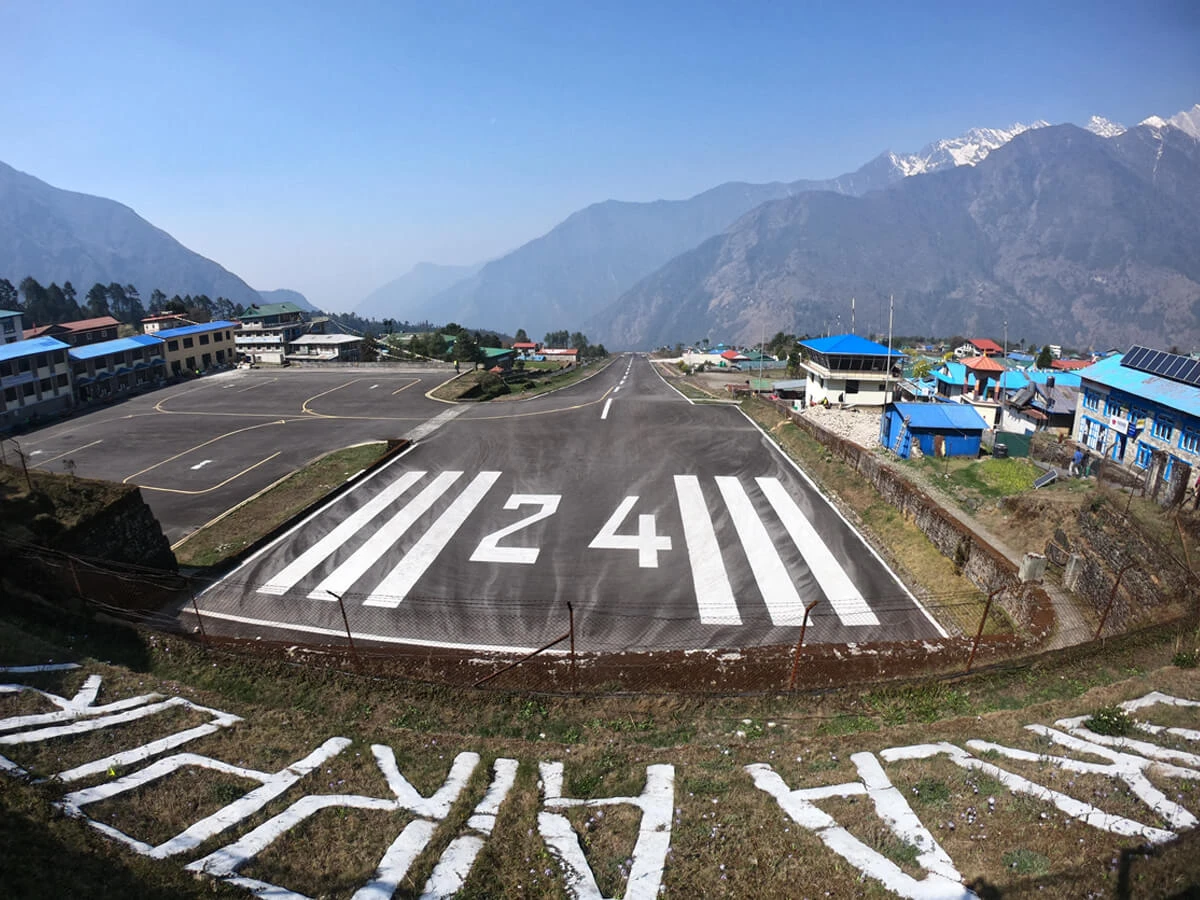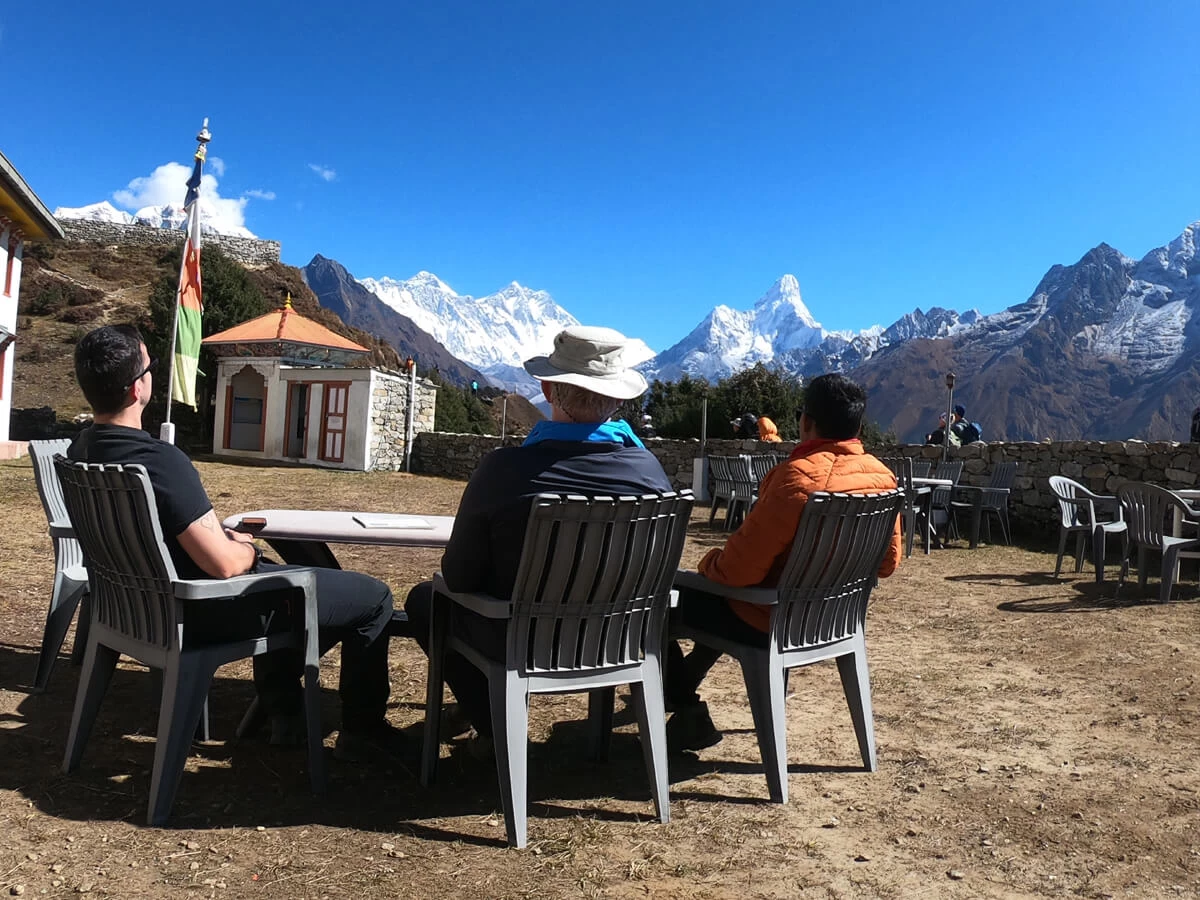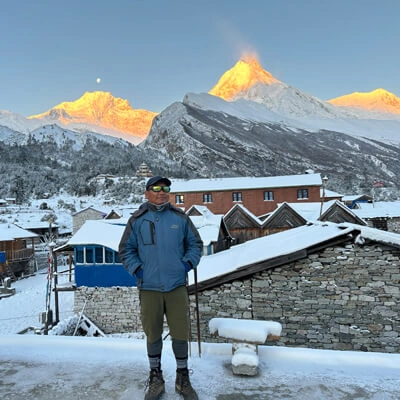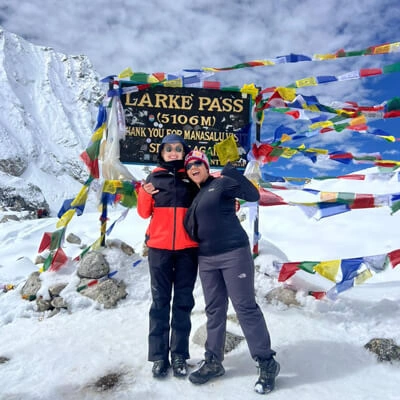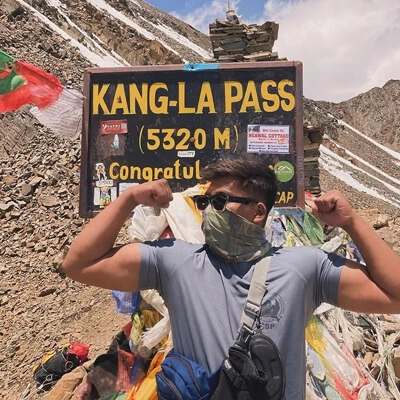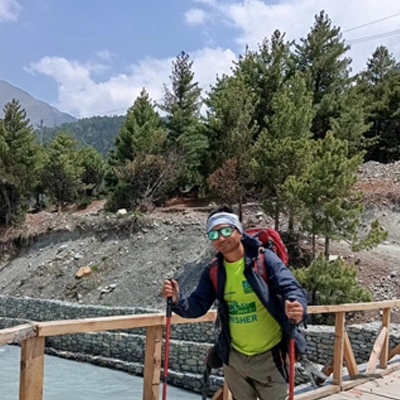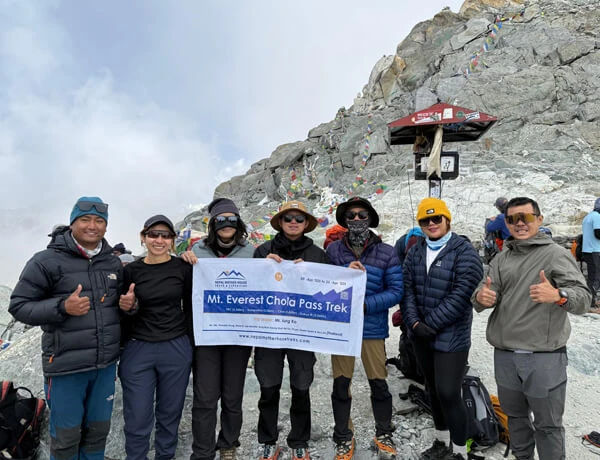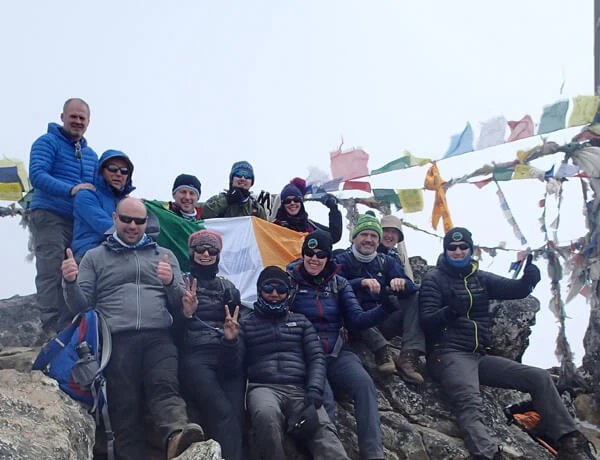The Everest Three Passes Trek is one of the Khumbu region's most adventurous teahouse treks. The area offers a wide variety of trekking routes, ranging from straightforward to challenging. The Everest 3 Passes trek goes through three challenging passes, such as Kongma La (5,535 m), Cho La (5,420 m), and Renjo La (5,360 m). All these passes will present you with stunning views of the Himalayas from a different perspective. Everest Three High Passes Trekking will allow you to explore the hidden corners of the Everest region.
This trek is ideal for those seeking adventure and excitement in the Himalayas. The trail is tough and will surely test your endurance. The EBC Three Passes Trek goes through several fine valleys and picturesque Sherpa villages, where you will get a chance to come closer to the locals. You will observe their unique culture, traditional cultivation, Buddhist practices, and their daily livelihood. In the lower area, the trail goes through dense forests, where you will get to see the rich vegetation of the region and rare wildlife, including snow leopards and musk deer. As you gain elevation, you will leave the tree line behind and enter the alpine zone. The trail becomes rockier and snowier.
We, Nepal Mother House Treks & Expedition, have designed the Everest Three Passes Trek Itinerary to present you with an unforgettable journey in the Khumbu region. You can check our Everest 3 Passes Trek Map for a better pictorial view of the route. With us, you will get a comprehensive package, authenticity, and years of expertise. You can contact us at any time for further queries.
Main Attractions of the Everest 3-Pass Trek
As this hike is a high-pass trek in the Khumbu, the trail goes across the Kongma La (5,535 m), Cho La (5,420 m), and Renjo La (5,360 m) passes, which are the main attractions of the trip. The trip rewards you with breathtaking mountain scenery, incredible glaciers, and tranquil lakes. Likewise, the attractions of the Everest 3 Passes Trek include Mt. Everest Base Camp (5,360 m), Khumbu Icefall, the most popular viewpoint, Kalapatthar (5,555 m), Gokyo Lakes, Gokyo Peak (5,360 m), and Nagjumba Glacier. In addition, the Everest View Hotel offers a wonderful panoramic view of the surrounding mountains, including Mt. Everest, Khumjung Village, Khumjung Monastery with Yeti Skull, Edmund Hillary School, and the beautiful Sherpa Village situated on the slopes of Mt. Khumbila, also known as Khumbu Yül-Lha (5,761 m), the protector deity of the Khumbu. Tengboche, one of the largest monasteries in the Khumbu, and Nangkartshang Peak (5,083 m) provide a breathtaking view of the world's highest three mountains, including Mt. Everest (8,848.86 m), Makalu Similarly, naturally gifted Namche Bazaar, the homeland of Everest submitters, Sherpa’s unique culture and tradition, Saturday markets, etc., are other remarkable ingredients of the Everest Three Pass Trek. UNESCO's World Heritage Site lists Sagarmatha National Park as the highest national park in the world.
What kind of transport is available for the Everest Three Passes Trek?
Lukla is the main entrance gate of the Everest Three Passes trek. More than three airlines operate daily flights from the capital city of Kathmandu to Lukla. It is a scenic, short 20- to 30-minute flight. We advise you to factor in a few extra days to return to Kathmandu after the trek, as poor visibility and wind sometimes prevent flying to Lukla and back. Occasionally, the flight experiences delays and cancellations lasting up to one day. The flight is the main mode of transportation for the Everest trek. You can also fly to Lukla by helicopter, which is pricier but makes for a memorable trip. Now, construction has extended the road to Phaplu, with Salleri aiming to connect with Lukla and eliminate reliance on air transport. The road access to Lukla will greatly assist the local people in transferring their daily necessities and other commodities while also allowing trekkers to avoid staying in Lukla and wasting time waiting for favorable weather conditions. The local government of Pasang Lhamu Rural Municipality has planned to complete the road within two years, integrating the Khumbu region into the national road network and run a daily bus from Kathmandu to Lukla. This approach helps to minimize transport expenses and other related services.
Are there teahouse facilities throughout the entire Everest Three High Passes Trek?
Everest is the most popular trekking destination in the world. Tea houses and hotels of various categories are available in the area. In this Everest Three High Pass Trek, you will stay overnight at a teahouse or guesthouse, per your requirements, in a single, double, or triple bedroom with an indoor common bathroom and toilet. Some places like Tengboche, Chhukung, Labuche, Gorak Shep, Dzongla, Thangnak, Marlung, etc. have just a few teahouses, so during the trekking peak season, the rooms will be overfull and need to be shared with other trekkers, or they will need to stay in a dormitory room. The chances of getting a single room are low. Since the tour is an adventure trek in the high Himalayas, you cannot compare the accommodation facilities with those in cities. Your room cost includes an additional charge for the hot shower, and you will need to bring your towel and other bathroom accessories. In some places, like Namche Bazaar, Lukla, and Phakding, you can find luxury hotels with the best amenities.
Food and Drinking Water on the Everest High Pass Trek
You can complete the Everest 3 Passes Trek at a teahouse, where you will stay in a guesthouse and receive meals. Sagarmatha National Park and the local tourism committee control the fixed-price menu cards for each teahouse. Breakfast, dinner, and lunch will be in the teahouse where you're staying and on the trail. With the exception of certain locations, such as nearby passes, every place offers a wide variety of food options. Most trekkers enjoy Nepali food, which includes dal bhat, rice, lentil soup, vegetables, curry, and pickles, and they often experiment with different dishes each day to satisfy their appetites. It is easy to cook the same item for many people, and it helps to minimize carbon dioxide by using less fuel and wood. By choosing these options, you contribute to environmental conservation. On the Everest High Passes Trek, most places typically offer a wide variety of food options, including rice (fried, plain), noodles (fried, with soup), potatoes (fried, boiled, or French fried), macaroni, spaghetti, pizza, yak steak, porridge, and more. Certain tea houses are required to serve various continental foods, including a set breakfast. It is easy to cook the same item for many people, and it helps to minimize carbon dioxide by using less fuel and wood.
Therefore, a professional cook maintains excellent testing and hygiene standards in every teahouse. Although some meat items can serve as food, it is advisable to steer clear of them. The meat is carried from below the Lukla, so it won’t be fresh. This could be due to stomach issues and other factors. Regarding drinking water, you can buy a bottle of mineral water in every teahouse and shop at a minimal cost. However, we at Nepal Mother House suggest treating the water yourself before drinking it; for this, you can use iodine, chlorine, a filter, or a UV SteriPen. The cost of water rises according to elevation gain.

Is the Everest Three Passes Trek Itinerary Flexible?
You can tailor the Everest Three Passes Trek itinerary to fit your holiday schedule. It can be completed in 17 days, which is the shortest time to make it longer than four weeks. However, we would like to recommend the 21-day Everest 3 High Passes Trek, including two days before the trek and one day after concluding it. This is the usual itinerary, which will be suitable for every trekker. First, you will fly to Lukla and head to the beautiful Sherpa settlement Namche Bazaar, Mount Everest Base Camp, and Kalapatthar (5,556 m) by crossing the first pass, Kongma La (5,535 m), through the Chhukung village, then traverse the second pass, Cho La (5,420 m), and get into the naturally blessed Gokyo Valley, where you will explore Nepal's longest glacier, Ngozumpa Glacier (36 km), visit the fifth lake, and climb the most wonderful viewpoint, Gokyo Ri (5,360 m), before crossing the third pass, Renjo La (5,360 m). Then you are descending to Marlung and the Thame Valley; hence, Thame is the homeland of Kamirita Sherpa, 54, who broke his own world record at 7:25 a.m. local time on Sunday, May 12, 2024, and successfully scaled the top of the world for the 30th time. As there are several side trips during the Three Pass Trek, you can change the Everest Three Pass Trek itinerary as you wish. He was born in 1970 AD in Thame village, Solukhumbu, Nepal.

Choose one of the Best Times of the Year for the Everest Three Pass Trek
September through November is the peak time of the year to go on the Everest Three Pass Trek. The sky is cloudless, and the views are prominent. Additionally, this is the ideal time to visit Nepal, as it coincides with several festivals such as Jataras, Dashain, Tihar (Dipawali), Chhath, and others. The temperature ranges from 15 to 25°C (59 to 77°F), making it perfect to traverse.
The other best time of the year to go on the Everest 3 Passes Trek is from March to May. The climate usually stays warm in lower regions and cool in upper parts. The temperature ranges from 15 to 20°C (59 to 68°F). As the winter has just ended, this time of year welcomes spring vegetation and flowers.
Are there direct flights available to Lukla from Kathmandu?
Yes! The Everest Trekkers' most crucial query is this one. Every year, Lukla flights are redirected to Manthali Airport in Ramechhap District due to heavy air traffic at Kathmandu Airport (Tribhuvan International Airport, TIA) in the trekking peak season of spring and autumn. According to the latest data from Sagarmatha National Park at Manjo Check Post, there were almost 800 trekkers (October 2023) in a day for the Everest Trek. A single airline company conducts more than 40 flights each day in the high season, and three airline companies are operating daily flights to Lukla: Tara Air, Summit Air, and Sita Air. Tara Air and Sita Air have double-engine aircraft, which are suitable for such remote regions.
The highest probability of flying to Lukla is from Ramechhap airport to avoid air traffic and take a flight in appropriate weather. For this reason, you must start the journey early in the morning, around 2–3:30 AM, to catch the flight. Or if you do not prefer to drive in the morning, you can drive to Ramechhap a day in advance and fly to Lukla the following morning. There are very basic tea houses and lodges available near the airport in Ramechhap.
There's no regular public transport service in the early morning, so passengers need a drive-by shared jeep or bus. For a small private group, hiring a private car offers more comfort and flexibility, but it comes at an additional cost. The trip cost includes sharing transport expenses during the Everest Three Passes Trek; however, if you require private transport, please contact us. It takes 4 to 5 hours to drive from Kathmandu to Manthali.
Flight delays can range from one hour to several days due to weather conditions. In such situations, one can either wait for improved weather conditions, opt for alternative land transportation, drive a Jeep to Salleri/Kharikhola/Thamdanda, or change the trip destination. There is another option to fly by helicopter to Lukla for about an additional USD 600 to 800 per person.
How is the village of Thame recovering from the recent flood? I hope everything will be back to normal by our Everest Three Passes trek in November.
Thame village is gradually getting over the last flood. The society is making enormous efforts to reconstruct and bring normality back. Although the process may take some time, we anticipate that by the time of our Everest Three Passes trip from October to November, things will have much improved.
The occasion is a month-long trip there, so the hotels will be ready by this time. We can walk to Thamo for the night if there isn't a hotel available, or we can go to Namche Bazaar. We are starting the trek anti-clockwise, which means it will take longer to reach Thame.
If you are looking for Clockwise Everest High Passes with the EBC trek itinerary, it is
Everest High Passes Trekking Suggested Itinerary—18 Days—Clockwise
Day 00: Arrival at Kathmandu, trek preparation, and permit paperwork day.
Day 01: KTM to Lukla [Drive from Kathmandu to Ramechhap (4-5 hours) and fly to Lukla (2,800 m) in 20 minutes, or KTM to Lukla flight 30 minutes]; trek to Phakding (2,640 m) in 3 to 4 hours.
Day 02: Phakding to Namche Bazaar (3,430 m)—5 to 6 hours
Day 03: Explore Namche Bazaar to Khumjung Village (3,790 m)—2 to 3 hours via Syangbuche Airport and Everest View Hotel (3,880 m), and hike to Hillary Viewpoint in Khunde/Gong (3,790 m)—2 to 1½ ½ hours.
Day 04: Namche Bazaar to Thame (3800m)—4 to 5 hours
Day 05: Acclimatization day in Thame (Explore around Thame)
Day 06: Thame to Marulung (4,150 m)—5 to 6 hours
Day 07: Marulung via Renjo La Pass (5360m) to Gokyo (4790m)—7 to 8 Hours
Day 08: Rest Day in Gokyo (4790m)/Explore day in Gokyo Peak (5360m)—2 hours
Day 09: Gokyo to Thangnak (4,700 -2 to 3 hours
Day 10: Thangnak to Dzongla (-6 to 7 hours via Chola Pass (5,420m)
Day 11: Dzongal to Lobuche (4,930m to 4 hours
Day 12: Lobuche to Gorakshep (5,140 3 hours & Everest Base Camp (5,360 -2 to 3 hours
Day 13: Gorakshep to Kalapathar (5,550 m)—2 hours & Stroll back to Lobuche (4,930 m)—5 to 6 hours
Day 14: Lobuche to Chukkung (4,730 m)—7 to 8 Hours
Day 15: Chhuking to Tangboche (3867m)—6 to 7 hours
Day 16: Tengboche to Namche Bazaar (3430m)—4 to 5 hours
Day 17: Namche Bazaar to Lukla Lukla (2,800 m)—7 to 8 hours
Day 18: Fly back to Kathmandu—30 minutes, then your destination.
Day 00: Your own (home) destination.
*Note: If you wish to make any changes during the trek, you can discuss the plan with your guide. The itinerary is quite flexible.

